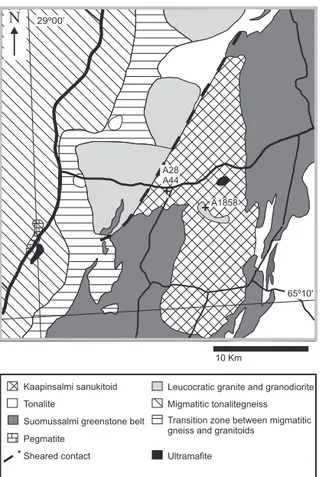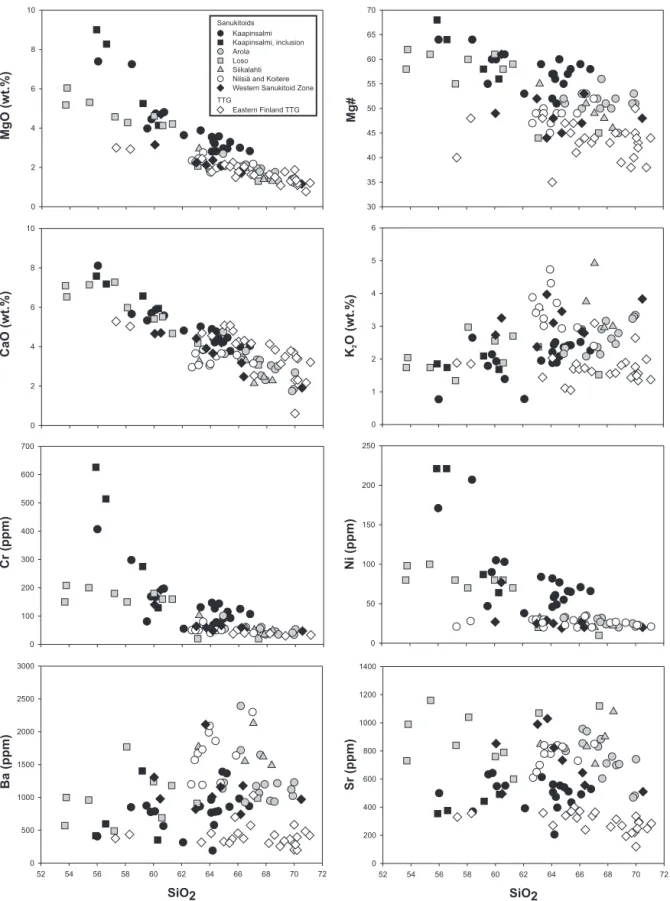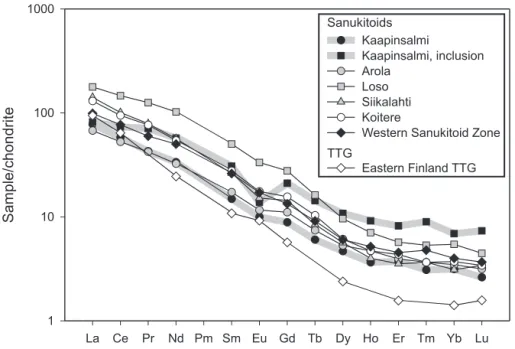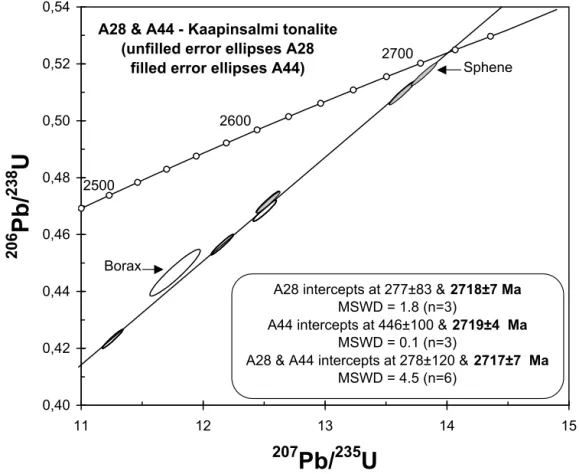Bulletin of the Geological Society of Finland, Vol. 79, 2007, pp. 117–125
Age and petrology of the Kaapinsalmi sanukitoid intrusion in
Suomussalmi, Eastern Finland
Esa Heilimo
1)*, Perttu Mikkola
2)and Jaana Halla
3)1) Department of Geology, P.O. Box 64, FI-00014, University of Helsinki, Finland
2) Geological Survey of Finland, P.O. Box 1237, FI-70211, Kuopio, Finland
3) Geological Museum, Finnish Museum of Natural History, P.O. Box 11, FI-00014, University of Helsinki, Finland
Short Communication
Key words: intrusions, sanukitoids, geochemistry, absolute age, U/Pb, zircon, Neoarchean, Kaapinsalmi, Suomussalmi, Finland
*Corresponding author email: esa.heilimo@helsinki.i
1. Introduction
Sanukitoids (high Mg-granitoids) are a group of dis-tinctive Neoarchean granitoids, which differ in chem-ical composition from the voluminous tonalite-trond-hjemite-granodiorite (TTG) suite. Shirey and Han-son (1984) first introduced the term sanukitoid to refer to mantle-derived rocks, which resemble high-Mg andesites, known as sanukites in the Miocene Setouchi belt of Japan. Stern et al. (1989) defined sanukitoid geochemistry as SiO2 = 55 – 60 %, MgO > 6 %, Mg# > 60, Sr > 600 – 1800 ppm, Ba > 600 – 1800 ppm, Cr > 100 ppm, Ni > 100 ppm and LREE enriched compared to HREE. The term sanukitoid series has been introduced for granitoids with rela-tively high Mg#, MgO, Sr, Ba, Cr and Ni at any given silica level (Lobach-Zhuchenko et al., 2005). Sanuki-toids composition shows some similarities to adakites (Martin, 1999) and to recently described Neoarchean Closepet-granites (Moyen et al., 2001).
Interpretation of the geochemistry of sanukitoids is controversial. High Mg#, MgO, Ni and Cr implies
that sanukitoids are mantle-derived rocks, but high Sr, Ba and LREE suggest crustal origin (Stern & Han-son, 1991). These aspects of sanukitoid geochemistry have been explained with a two-stage process, which includes Archean subduction. In the first stage, melts and/or fluids derived from a subducting basaltic slab enriched the overlying mantle wedge with Sr, Ba and LREE. Later melting of the enriched mantle gener-ated sanukitoid magmas (Stern & Hanson, 1991; Kovalenko et al., 2005). Pb isotopic studies indicate that subducted sediments may also have played an important role in the sanukitoid petrogenesis (Halla, 2005). Sanukitoids might thus be the first sign of ex-istence of an enriched mantle wedge and the begin-ning of the modern style of plate tectonics (Martin & Moyen, 2005).
~2.9 Ga sanukitoids from the Pilbara craton (Smith-ies & Champion, 2000), and the ~2.89 Ga sanuki-toids from the Amazonian craton (Oliveira et al., 2006) are the only sanukitoid intrusions known to be older than ~2.7 Ga.
More than 20 sanukitoid intrusions have been found in the Karelian craton. Sanukitoid intrusions in the Russian part of the Karelian craton are divid-ed into Eastern and Western sanukitoid zones, which differ in composition and age (Lobach-Zhuchenko et al., 2005; Bibikova et al., 2005). Seven sanukitoid intrusions located in Finland have been described:
Kuittila (O’Brien et al., 1993), Nilsiä, Koitere (Halla, 2005), Arola, Loso, Siikalahti (Käpyaho et al., 2006; Käpyaho 2006) and the recently recognised Kaapin-salmi sanukitoid intrusion(Heilimo, 2006a; 2006b) (Fig. 1). This paper describes in more detail the petrology of the Kaapinsalmi sanukitoid intrusion.
2. Geological setting
The Kaapinsalmi sanukitoid intrusion is located in Suomussalmi, in the Kianta terrain on the western margin of the Archean Karelian craton (Fig. 1). The
Age and petrology of the Kaapinsalmi sanukitoid intrusion in Suomussalmi, Eastern Finland 119
Kianta terrain is a granite-greenstone terrain consist-ing mostly of migmatitic gneisses, greenstone belts, paragneisses and granitoids (Sorjonen-Ward & Luuk-konen, 2005). Migmatitic Päivärinta gneiss in the vicinity of Kaapinsalmi has mesosome aged 2.83 – 2.84 Ga and leucosome aged between 2.70 – 2.67 Ga (Käpyaho et al., 2007). Greenstone belts in the Kian-ta terrain have been tectonically segregated into Ti-pasjärvi, Kuhmo, and Suomussalmi greenstone belts. The ages of the greenstone belts are between ~2.80 – 2.83 Ga (Luukkonen, 1992). Nurmes-type parag-neisses in the Kianta terrain evidently have protolith ages as young as ~2.71 – 2.69 Ga (Kontinen et al., 2007). Granitoids of the Kianta terrain are metamor-phosed, but they have preserved their magmatic tex-ture. Käpyaho et al. (2006) and Käpyaho (2006) have divided the Kianta granitoids into three magmatic
episodes: 1) TTG-granitoids 2.83 – 2.74 Ga, 2) sanukitoids 2.74 – 2.70 Ga and 3) leucocratic gran-ites and granodiorgran-ites 2.70 – 2.68 Ga.
The Kaapinsalmi sanukitoid lies adjacent to the western margin of the Suomussalmi greenstone belt (Fig. 2). It has intrusive contacts with the green-stone belt and contains greengreen-stone xenoliths, con-tactswith granitoids are sheared and no contact has been observed with migmatitic gneisses. Within the Kaapinsalmi sanukitoid there is a small, brecciating intrusion of leucogranodiorite called Kivilahti. The Kaapinsalmi sanukitoid is mineralogically tonalite and also contains melatonalite inclusions. The tex-ture of the Kaapinsalmi sanukitoid is granular and mortar. The major minerals are plagioclase, quartz, hornblende and biotite, while accessory minerals in-clude microcline, sphene, allanite, apatite, zircon and opaque minerals. The secondary minerals are biotite, epidote, sericite, saussurite, chlorite and carbonate.
3. Geochemistry
The Kaapinsalmi sanukitoid and melatonalite in-clusions display distinct sanukitoid characteristics: low SiO2 and high Mg#, MgO, Ni, Cr (Fig. 3). The Kaapinsalmi sanukitoid is intermediate (SiO2 56.0 – 66.8 %) and has high Mg# (51.3 – 64.2). There is a 2.8 – 7.4 % variation in MgO, while Ni and Cr abundances are greater compared to eastern Finland TTGs. The K2O content of the Kaapinsalmi sanuki-toid is 0.8 – 2.7 %, while Sr varies between 206 ppm and 643 ppm and Ba from 316 ppm to 1366 ppm. Melatonalite inclusions of the Kaapinsalmi sanuki-toid have slightly higher Mg# and higher contents of MgO, Ni and Cr than the Kaapinsalmi sanukitoid, with Cr abundances ofup to 626 ppm and Ni abun-dances ofup to 221 ppm; respective numbers for the Kaapinsalmi sanukitoid are 408 ppm and 207 ppm. The Kaapinsalmi sanukitoid and inclusions both have fractioned REE patterns with higher HREE than average eastern Finland TTG. Average (La/Lu)n for the Kaapinsalmi sanukitoid is 21.2 and for the mela-tonalite inclusions 12.2 (Fig. 4).
Age and petrology of the Kaapinsalmi sanukitoid intrusion in Suomussalmi, Eastern Finland 121
4. U-Pb dating methods
Two samples from the Kaapinsalmi sanukitoid were collected for U-Pb dating (A28 by Eero Pehko-nen and A44 by Erkki LuukkoPehko-nen, see Fig. 2). U
-Pb samples were treated with methods described by Vaasjoki (2001) in 1978 and 1981 by Olavi Kou-vo and staff of the isotopic laboratory of Geologi-cal Survey of Finland. Samples were washed, crushed and sorted on a wet shaking table and then treated with heavy liquids (bromofrom and Clerici™) and a Frantz magnetic separator. Zircon and sphene grains were selected for analysis by handpicking. U and Pb multigrain analyses were done using Krogh’s method (1973). 235U-208Pb -spiked and unspiked isotopic
ra-tions were measured using thermal ionisation single collector mass spectrometer (TIMS) at the isotopic laboratory of Geological Survey of Finland, Espoo. U-Pb calculations were done with PbDat (Ludwig, 1991) and IsoPlot/Ex (Ludwig, 2003) programs.
5. U-Pb dating results
Zircons from the Kaapinsalmi sanukitoid were light brown and translucent in the heavy fraction. Crystal shapes were pyramidic and prismatic from subhedral to euhedral. Sample A28A was originally analysed by Kouvo & Tilton (1966) using old borax method and the resulting 207Pb/206Pb age was 2681 Ma.
After-wards, three discordant zircon fractions from sample A28 were analysed producing an upper intersect at 2718 ± 6 Ma. Additional sample A44 gave an upper intersect at 2719 ± 4 Ma, with two discordant zircon fractions and an almost concordant sphene fraction. Both ages are same within the error limits. A com-bined age of 2716 ± 9 Ma from both samples (A28 & A44) is thus a relatively good estimate of the Kaapin-salmi sanukitoid intrusion age (Fig. 5, Table 1).
Kivilahti leucogranodiorite located inside the Kaapinsalmi sanukitoid was also sampled (A1858) (see Fig. 2) for U-Pb dating. However, separation did not produce enough zircon or monazite for TIMS analysis.
6. Discussion
In the Karelian craton, sanukitoids are younger than the surrounding TTG,implying that sanukitoids are not directly linked to the subduction processes that might have produced TTGs (Bibikova et al., 2005). The sanukitoid intrusions of the Russian part of the Karelian craton are divided into Eastern and Western sanukitoid zones (Lobach-Zhuchenko et al., 2005; Bibikova et al., 2005). The sanukitoid intrusions in the Eastern sanukitoid zone were formed 2.730 – 2.745 Ga ago. They are more mafic in composi-tion, with higher MgO, Ni, Cr and lower Ba, Sr com-pared to the Western sanukitoid zone intrusions. The Eastern sanukitoid zone also shows more
heteroge-neity and a larger mantle-derived component than the Western sanukitoid zone. The Western sanuki-toid zone is younger, with intrusions in the age range 2.700 – 2.720 Ga.
Location, age (~2.72 Ga) and composition of the Kaapinsalmi sanukitoid all show certain similarities to the Western sanukitoid zone (Figs. 1, 3 & 4), al-though the Mg#, MgO, Ni and Cr contents of the Kaapinsalmi sanukitoid are higher at their respec-tive SiO2 level than in the other west Karelian sanuki-toids (Fig. 4). The Kaapinsalmi sanukitoid also has relatively low Ba and Sr contents when compared to those of the Western sanukitoid zone and other Finn-ish sanukitoids. Comparatively low K2O, Ba, Sr and
2700
0,40 0,42 0,44 0,46 0,48 0,50 0,52 0,54
11 12 13 14 15
207
Pb/
235U
2
0
6
Pb/
2
3
8
U
A28 intercepts at 277±83 & 2718±7 Ma
MSWD = 1.8 (n=3)
A44 intercepts at 446±100 & 2719±4 Ma
MSWD = 0.1 (n=3)
A28 & A44 intercepts at 278±120 & 2717±7 Ma
MSWD = 4.5 (n=6)
A28 & A44 - Kaapinsalmi tonalite (unfilled error ellipses A28
filled error ellipses A44)
Borax
Sphene
2600
2500
Age and petrology of the Kaapinsalmi sanukitoid intrusion in Suomussalmi, Eastern Finland 123
high MgO, Ni, Cr contents make the Kaapinsalmi sanukitoid a distinct sanukitoid in western part of the Karelian craton. The Rio Maria sanukitoid, lo-cated in the Amazonian craton in Brazil (Oliveira et al., 2006), is similar in composition to the Kaapinsal-mi sanukitoid.
Current models for the petrogenesis of sanuki-toids propose that fluids and/or melts from subduct-ed basaltic slab and possible ssubduct-ediments enrichsubduct-ed the overlying mantle wedge. Subsequent melting of the enriched mantle wedge then formed the sanukitoid magmas. Sanukitoids thus might contain material from three different sources: basaltic slab, sediments and mantle wedge (Stern & Hanson, 1991; Kova-lenko et al., 2005; Halla, 2005). A probable source of MgO, Ni and Cr is the mantle wedge; and of K2O, Ba and Sr the slab melts and/or fluids from a crustal component, possibly subducted sediments.
There are two possible explanations for the distinct composition of the Kaapinsalmi type sanukitoid: 1) Less involvement of recycled crustin the petrogene-sis of the Kaapinsalmi type sanukitoid. This could ex-plain the lower K2O, Sr and Ba contents and higher MgO, Ni and Cr content. 2) Heterogeneity in the en-richment of the mantle wedge could also explain the composition of Kaapinsalmi type sanukitoid. If flu-ids and/or melts from the basaltic slab and possible sediments infiltrated themantle wedge in an irregu-lar manner, then partial melting of the less enriched parts of the wedge would have caused Kaapinsalmi type sanukitoid magmas. These two explanations are not mutually exclusive and could occur simultane-ously.
7. Conclusions
The newly-recognised Kaapinsalmi intrusion has chemical composition similar to sanukitoid. Its age, location and certain compositional similarities indi-cate that it forms the northern extension of the West-ern sanukitoid zone of the Karelian craton. How-ever, there are two important geochemical differences between the Kaapinsalmi sanukitoid and with other West Karelian sanukitoids:
T a b le 1 . T IM S U -P b da ta f ro m t he K aa pi ns al m i t on al it e (A 28 & A 44 ). S ample infor mation density S ample w eight/mg
U Pb
206 Pb/ 204 Pb 208 Pb/ 206 Pb I sotopic ratios* Rho** A ppar
ent ages / M
a ppm measur ed radiogenic 206 Pb/ 238 U 2 σ % 207 Pb/ 235 U 2 σ % 207 Pb/ 206 Pb 2 σ % 206 Pb/ 238 U 207 Pb/ 235 U 207 Pb/ 206 Pb A28-K aapinsalmi tonalite A28A. T otal (borax) 611.6 345 184 1588 0.168 0.4466 1.3 11.270 1.5 0.1831 0.5 0.94 2380 2546 2681 A28B. +4.6 23.6 270 153 2322 0.194 0.4684 0.7 12.006 0.7 0.1859 0.2 0.96 2476 2604 2706 A28C. 4.2-4.6 21.8 411 220 2158 0.147 0.4565 0.7 11.657 0.7 0.1852 0.2 0.97 2424 2577 2700 A28D. 3.8-4.0 5.9 638 307 2265 0.113 0.4233 0.7 10.757 0.7 0.1843 0.2 0.97 2275 2502 2692 A44-K aapinsalmi tonalite A44A. +4.6/+200 24.2 170 106 12411 0.234 0.5098 0.7 13.131 0.7 0.1868 0.2 0.97 2655 2689 2714 A44B. 4.2-4.6 20.8 240 137 5746 0.210 0.4715 0.7 12.029 0.7 0.1850 0.2 0.97 2490 2606 2698 A44C. S phene 31.2 57 40 499 0.257 0.5166 0.7 13.318 0.7 0.1870 0.3 0.91 2684 2702 2716 *) I
sotopic ratios corr
ected for fractionation. blank and age r
elated common lead (S
tacey and Kramers. 1975).
1. The Kaapinsalmi sanukitoid has lower SiO2 and higher MgO, Ni, and Cr contents compared to those of the other west Karelian sanukitoids, indi-cating that the primary source of the Kaapinsalmi sanukitoid was mantle peridotite.
2. The Kaapinsalmi sanukitoid has relatively low K2O, Ba, and Sr concentrations. This might indicate smaller recycled crustal sediment component in the source of the Kaapinsalmi sanukitoid than in more felsic sanukitoids and/or mantle heterogeneity.
Acknowledgements
We would like to thank journal referee Svetlana Lo-bach-Zhuchenko for thoughtful review of the manu-script. Olavi Kouvo and staff of the isotopic laborato-ry of Geological Survey of Finland are acknowledged for isotopic determinations. Peter Sorjonen-Ward is thanked for comments and reviewing the language and Mikko Pitkänen for reviewing the language. This work was done as part of the GSF’s regional bedrock mapping in the Suomussalmi area.
References
Artemenko, G.V., Lobach-Zhuchenko, S.B., Krylov, I.N. & Orsa, V.I., 2003. Archean high-Mg granitoids (sanuki-toids) in the Ukrainian Shield and its comparison with rocks of TTG suite. Geophysical Research Abstracts 5. Abstracts of the Contributions of the EGS-AGU-EUG Joint Assembly, Nice, France, 06−11 April, 2003. Euro-pean Geophysical Society (CD-ROM).(CD-ROM).
Bibikova, E.V., Petrova, A. & Claesson, S., 2005. The tem-The tem-poral evolution of sanukitoids in the Karelian craton, Baltic Shield: an ion microprobe U−Th−Pb isotopic study of zircons. Lithos 79, 129–145.
Halla, J., 2005. Late Archean high-Mg granitoids (sanuki-toids) in the Southern Karelian domain, Eastern Finland. Lithos 79, 161–178.
Heilimo, E., 2006a. Petrography and geochemistry of thePetrography and geochemistry of the Kaapinsalmi 2.72 Ga Sanukitoid intrusion, Eastern Fin-land. Bulletin of the Geological Society of Finland, Spe-cial Issue 1, p. 47.
Heilimo, E., 2006b. Kaapinsalmen sanukitoidin ja sitä ympäröivien granitoidien petrologia ja geokemia. Un- Un-published M.Sc. Thesis (available at request from the author), University of Helsinki, Finland, 62 p.
Koistinen, T., Stephens, M.B., Bogatchev, V., Nordgulen, Ø., Wennerström, M. & Korhonen, J., (eds.), 2001. Geological map of the Fennoscandian Shield, scale
1:2 000 000. Geological Surveys of Finland, Norway, Sweden and the North-West department of Natural Re-sources of Russia.
Kontinen, A., Käpyaho, A., Huhma, H., Karhu, J., Matu-kov, D.I., Larionov, A. & Sergeev, S.A., 2007. NurmesNurmes paragneisses in Eastern Finland, Karelian craton: Prove-nance, tectonic setting and implications for Neoarchae-an craton correlation. PrecambriNeoarchae-an Research 152,119– 148.
Kouvo, O. & Tilton, G., 1966. Mineral ages from the Finn-ish Precambrian. Journal of Geology 74, 421–442. Kovalenko, A., Clemens, J.D. & Savatenkov, V., 2005. Petro-
Petro-genetic constraints for the genesis of Archaean sanukitoid suites: geochemistry and isotopic evidence from Karelia, Baltic Shield. Lithos 79, 147–160.
Krogh, T.E., 1973. A low-contamination method for hy-drothermal decomposition of zircon and extraction of U and Pb for isotopic age determinations. Geochimica et Cosmochimica Acta 37, 485–494.–494.494.
Käpyaho, A., 2006. Whole-rock geochemistry of some to-nalite and high Mg/Fe gabbro, diorite, and granodiorite plutons (sanukitoid suite) in the Kuhmo district, East-ern Finland. Bulletin of the Geological Society of Fin-land 78, 121–141.
Käpyaho, A. Mänttäri, I. & Huhma, H., 2006. Growth of Archaean crust in the Kuhmo district, Eastern Finland: U−Pb and Sm−Nd isotope constraints on plutonic rocks. Precambrian Research 146, 95–119.
Käpyaho, A., Hölttä, P. & Whitehouse J.W. 2007. U–Pb zircon geochronology of selected Neoarchaean migma-tites in eastern Finland. Bulletin of the Geological Soci-ety of Finland 79, 95–115.
Lobach-Zhuchenko, S.B., Rollinson, H.R., Chekulaev, V.P., Arestova, N.A., Kovalenko, A.V., Ivanikov, V.V., Guseva, N.S., Sergeev, S.A., Matukov, D.I. & Jarvis, K.E., 2005. The Archaean sanukitoid series of the Baltic Shield: geo-logical setting, geochemical characteristics and implica-tion for their origin. Lithos 79, 107–128.
Ludwig, K.R., 1991. PbDat 1.21 for MS-dos: A comput-er program for processing Pb-U-Th isotope data. Vcomput-er--U-Th isotope data. Ver-U-Th isotope data. Ver--Th isotope data. Ver-Th isotope data. Ver-sion 1.08. U.S. Geological Survey Open-File Report 88–– 542, 35 p.
Ludwig, K.R., 2003. Isoplot/Ex 3. A Geochronological Toolkit for Microsoft Excel. Berkeley Geochronologicy Center, Special Publication No. 4.
Luukkonen, E.J., 1992. Late Archean and early ProterozoicLate Archean and early Proterozoic structural evolution in the Kuhmo-Suomussalmi terrain, Eastern Finland. Annales Universitatis Turkuensis. Sarja-Annales Universitatis Turkuensis. Sarja-Ser. A.II. Biologica-Geographica-Geologica 78, 113 p.A.II. Biologica-Geographica-Geologica 78, 113 p. Martin, H., 1987. Petrogenesis of of Archaean
trond-hjemites, tonalites, and granodiorites from Eastern Fin-land: Major and trace elements geochemistry. Journal of Petrology, 28, 921–953.
Age and petrology of the Kaapinsalmi sanukitoid intrusion in Suomussalmi, Eastern Finland 125
Martin, H. & Moyen, J.-F., 2005. The Archaean-Protero-zoic transition: Sanukitoid and Closepet type magma-tism. Mineralogical Society of Poland - Special papers Volume 26, 57–68.
Moyen, J.-F., Martin, H. & Jayananda, M., 2001. Multi-ele-M., 2001. Multi-ele- Multi-ele-ment geochemical modeling of crust-mantle interactions during late-Arhaean crustal growth: the Closepet granite (South Indian). Precambrian Research 112, 87–105. O’Brien, H., Huhma, H. & Sorjonen-Ward, P., 1993. Petro-
Petro-genesis of the late Archean Hattu Shist belt, Ilomant-si, Eastern Finland: geochemistry and Sr, Nd isotopic composition. Geological Survey of Finland, Special Pa-per 17, 147–184.
Oliveira, M.A., Dall’Agnol, R. & Althoff, F.J., 2006. Pe-trography and geochemistry of the Archean sanukitoid Rio Maria granodiorite and mafic rocks associated, Rio Maria granite-greenstone terrane, Amazon craton. In: Dall’Agnol, R., Rosa-Costa, L.T. & Klein, E.L. (eds.) Symposium on magmatism, crustal evolution, and met-allogenesis of the Amazonian craton. Abstracts volume and field trips guide. Belém, PRONEX-UFPA/SBG-NO, p. 29.
Rollinson, H. & Martin, H., 2005. Geodynamic controls on adakite, TTG and sanukitoid genesis: implications for models of crust formation Introduction to the Spe-cial Issue. Lithos 79, ix–xii.
Shirey, S.B. & Hanson, G.N., 1984. Mantle-derived Ar-chaean monzodiorites and trachyandesites. Nature 310, 222−224.
Sorjonen-Ward, P. & Luukkonen, E.J., 2005. Archean rocks. In: Lehtinen M., Nurmi, P.A. & Rämö, O.T. (eds.) Pre- Pre-cambrian Geology of Finland – Key to the evolution of the Fennoscandian shield. Developments in Precambrian Geology 14, Elsevier, Amsterdam, pp. 19–100. Smithies, R.H. & Champion, D.C., 2000. The Archaean
high-Mg diorite suite: links to tonalite−trondhjemite− granodiorite magmatism and implications for early Ar-chaean crustal growth. Journal of Petrology 41, 1653– 1671.
Taylor, S.R. & McLennan, S.M., 1985. The continentalThe continental crust: its composition and evolution. Blackwell, Oxford, 312 p.
Stacey, J.S. & Kramers, J.D., 1975. Approximation of ter-restrial lead isotope evolution by two-stage model. Earth and Planetary Science Letters 26, 207–221.
Stern, R.A., Hanson, G.N. & Shirey, S.B., 1989. Petrogene-nesis of mantle-derived, LILE-enriched Archean monzo-diorites and trachyandesites (sanukitoids) in southwest-ern Superior Province. Canadian Journal of Earth Sci-ence 26, 1688–1712.
Stern, R.A. & Hanson, G.N., 1991. Archaean high-MgArchaean high-Mg granodiorite: a derivative of light rare earth element-enriched monzodiorite of mantle origin. Journal of Pet-rology 32, 201–238.
Vaasjoki, M., 2001. Three decades of U–Pb mineral




